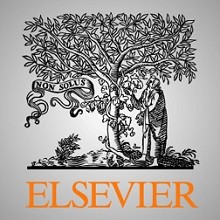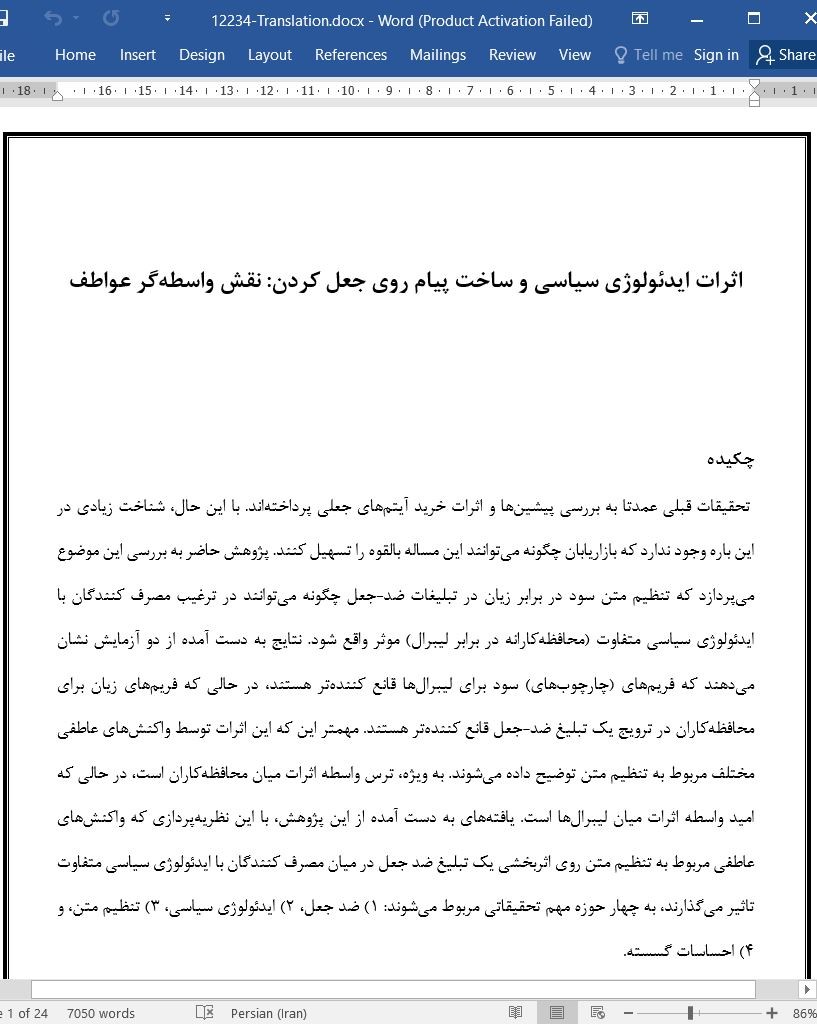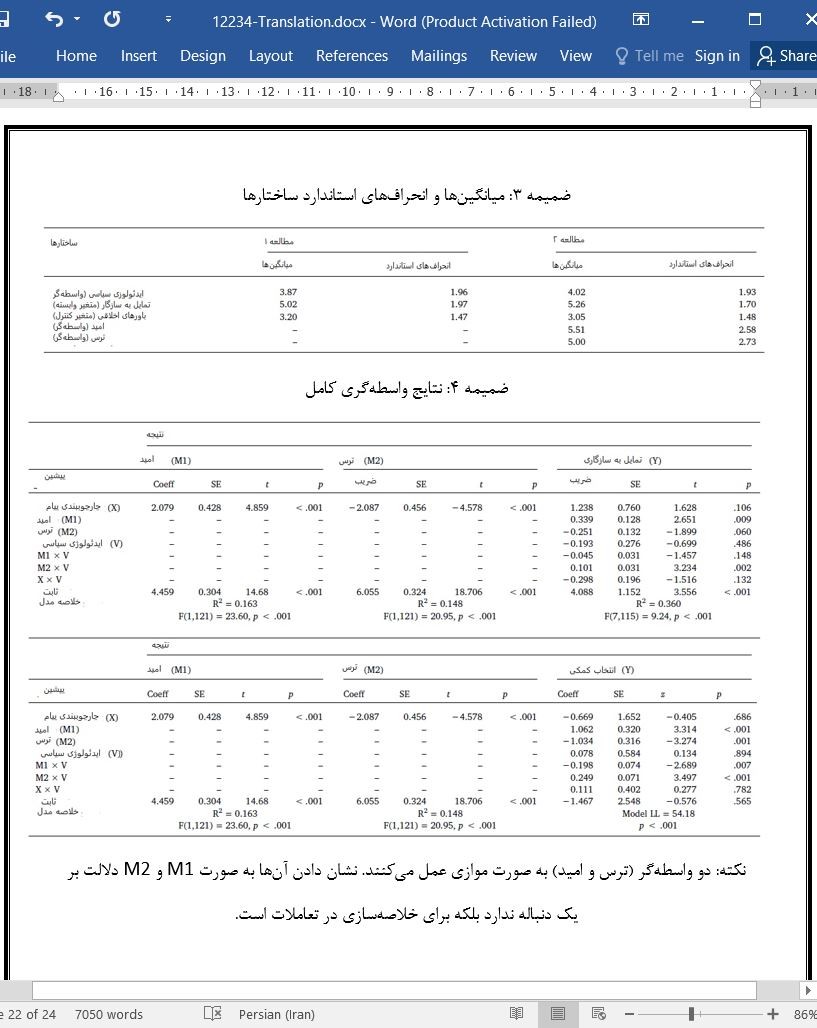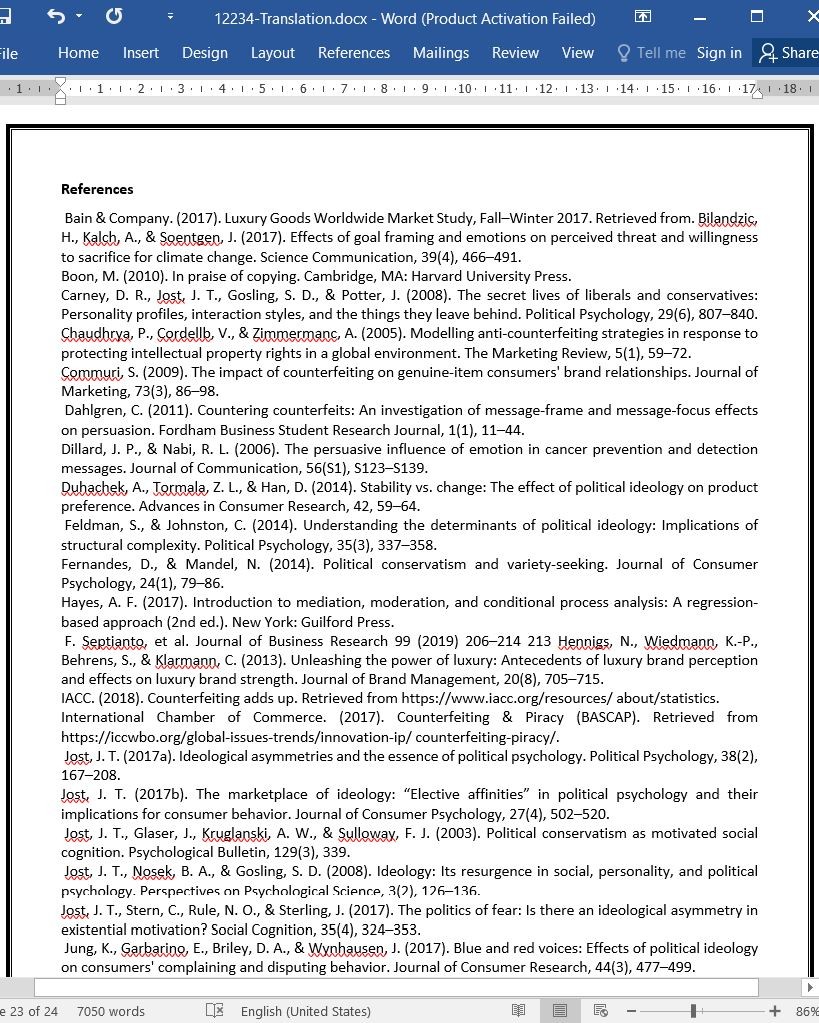
اثرات ایدئولوژی سیاسی و ساخت پیام روی جعل کردن: نقش واسطه گر عواطف
چکیده
تحقیقات قبلی عمدتا به بررسی پیشینها و اثرات خرید آیتمهای جعلی پرداختهاند. با این حال، شناخت زیادی در این باره وجود ندارد که بازاریابان چگونه میتوانند این مساله بالقوه را تسهیل کنند. پژوهش حاضر به بررسی این موضوع میپردازد که تنظیم متن سود در برابر زیان در تبلیغات ضد-جعل چگونه میتوانند در ترغیب مصرف کنندگان با ایدئولوژی سیاسی متفاوت (محافظهکارانه در برابر لیبرال) موثر واقع شود. نتایج به دست آمده از دو آزمایش نشان میدهند که فریمهای (چارچوبهای) سود برای لیبرالها قانع کنندهتر هستند، در حالی که فریمهای زیان برای محافظهکاران در ترویج یک تبلیغ ضد-جعل قانع کنندهتر هستند. مهمتر این که این اثرات توسط واکنشهای عاطفی مختلف مربوط به تنظیم متن توضیح داده میشوند. به ویژه، ترس واسطه اثرات میان محافظهکاران است، در حالی که امید واسطه اثرات میان لیبرالها است. یافتههای به دست آمده از این پژوهش، با این نظریهپردازی که واکنشهای عاطفی مربوط به تنظیم متن روی اثربخشی یک تبلیغ ضد جعل در میان مصرف کنندگان با ایدئولوژی سیاسی متفاوت تاثیر میگذارند، به چهار حوزه مهم تحقیقاتی مربوط میشوند: ۱) ضد جعل، ۲) ایدئولوژی سیاسی، ۳) تنظیم متن و ۴) احساسات گسسته.
۱. پیشگفتار
در طی دهه گذشته، بازار جهانی کالاهای لوکس به سرعت رو به افزایش بوده است. در حالی که تحقیقات اخیر (بین و کامپنی، ۲۰۱۷)، ارزش بازار جهانی لوکس را تقریبا ۵/۱ تریلیون دلار براورد میکنند، چنین رشد و اندازهای بدین معنا است که بازار برای نیروهایی باز شده است که سعی در به اشتراکگذاری فساد دارند. یکی از چنین تهدیدهایی تهدید کالاهای لوکس تقلبی است. با توجه به این که هزینههای تولید مواد جعلی به طور پیوسته کاهش یافته است، این امر به ویژه در سالهای اخیر اتفاق افتاده است (هنیگز، ویدمن، بهرنز و کلارمن، ۲۰۱۳). به همین دلیل، اطلاعات بازار (اتاق بازرگانی بینالمللی، ۲۰۱۷) نشان میدهند که تا سال ۲۰۲۲، جعل و دزدی منجر به ۲/۴ تریلیون دلار زیان در اقتصاد جهانی خواهد شد که بیش از ۵ میلیون شغل مشروع را به خطر خواهد انداخت. با توجه به خطرات بالا، نیاز به تحقیقاتی است که شناخت بهتری از عوامل موثر بر جعل را به منظور کاهش ریسک و توسعه مداخلات موثر بر عرضه و تقاضای کالاهای لوکس جعلی فراهم سازند.
Abstract
Prior research has mostly examined the antecedents and impacts of purchasing counterfeits. However, there is little understanding of how marketers can mitigate this potential issue. The current research examines how gain versus loss message framing in an anti-counterfeit ad can be effective in persuading consumers with different political ideology (conservative vs. liberal). Results from two experiments show gain frames are more persuasive for liberals, whereas loss frames are more persuasive for conservatives in promoting an anti-counterfeit ad. Importantly, these effects are explained by different emotional reactions associated with message framing. Specifically, fear mediates the effects among conservatives, while hope mediates the effects among liberals. Findings from the current research joins four important research areas, including (1) anti-counterfeit, (2) political ideology, (3) message framing, and (4) discrete emotions, by theorizing that emotion reactions associated with message framing influence the effectiveness of an anti-counterfeit ad among consumers with different political ideology.
1. Introduction
The global luxury market has been increasing rapidly over the past decade. While recent research (Bain & Company, 2017) estimates the value of the global luxury market at almost $1.5 trillion, such growth and size means the market is open to forces that may try to share the spoils. One such threat is that of counterfeit luxury goods. This is particularly the case in recent times, given the costs to produce counterfeits are constantly being lowered (Hennigs, Wiedmann, Behrens, & Klarmann, 2013). Because of this, market information (International Chamber of Commerce, 2017) suggests that by 2022 counterfeiting and piracy will lead to $4.2 trillion in losses from the global economy, jeopardizing over 5 million legitimate jobs. Given the high stakes, research is required that provides better understanding of the factors that influence counterfeiting in order to mitigate risk and develop interventions that affect supply and demand of counterfeit luxury goods.
چکیده
۱. پیشگفتار
۲. پیشزمینه نظری
۲.۱. ایدئولوژی سیاسی
۲.۲. ساخت پیامدهای گزارشگری مالی
۲.۳. نقش واسطهگر احساسات
۳. متدلوژی
۳.۱. مطالعه ۱
۳.۱.۱. روشها
۳.۱.۲. نتایج و بحث
۳.۲. مطالعه ۲
۳.۲.۱. روشها
۳.۲.۲. نتایج
۳.۲.۲.آ. اثربخشی تبلیغات ضد-جعل
۳.۲.۲.ب. فرایند زیربنایی
۴. بحث کلی
۴.۱. نقشهای نظری
۴.۲. پیامدهای مدیریتی
۴.۳. تحقیقات آینده و نتیجهگیری
منابع
ABSTRACT
1. Introduction
2. Theoretical background
2.1. Political ideology
2.2. Message framing
2.3. The mediating role of emotions
3. Methodology
3.1. Study 1
3.1.1. Methods
3.1.2. Results and discussion
3.2. Study 2
3.2.1. Methods
3.2.2. Results
3.2.2a. Effectiveness of anti-counterfeit ads
3.2.2b. Underlying process
4. General discussion
4.1. Theoretical contributions
4.2. Managerial implications
4.3. Future research and conclusion
References
- اصل مقاله انگلیسی با فرمت ورد (word) با قابلیت ویرایش
- ترجمه فارسی مقاله با فرمت ورد (word) با قابلیت ویرایش، بدون آرم سایت ای ترجمه
- ترجمه فارسی مقاله با فرمت pdf، بدون آرم سایت ای ترجمه



